Sister Apple, Sister Pig, a book of images and text by Mary Walling Blackburn, emulates a lost literary genre: photo-illustrated children’s books of the 1960s and ’70s that cast the child as a protagonist, problem-solver, and model for action in the world. To use this genre is a radical gesture, as modern discourses on abortion have focused largely on the mother’s experience. Nineteenth-century patent medicine companies, for instance, advertised pills for “female irregularity” and “complaints incidental to the female frame.”1 In the late 1960s, Western middle class consciousness-raising groups sought to understand abortion as an opportunity for women’s self-knowledge.2 Later third-wave feminists countered this argument by honoring the traumatic aspects of abortion for the mother, seeking to establish “the death of the fetus [as] a real death.”3 Right-wing activists now concretize this “real death” in the form of bloody fetus photos. Children themselves, however—both living and dead—remained strangely voiceless.
For Mary Walling Blackburn, the child protagonist in Sister Apple Sister Pig does not seek to reclaim narrative power. Rather, this child’s adventures and the photographs that depict them activate a cascade of contingent relations that displace subjectivity and voice altogether. Lee, the non-gendered main character, masks their own face with a leaf of kale and then proceeds to identify the objects that might house, represent, or capture an aborted sister (the titular apple and pig are two examples). No forms cohere; no identities are fixed. Even as Lee constructs and begins to master the surrounding space, superhero comics and costumes offer opportunities to become someone else. The speculative bibliography that follows the text below assures that another kind of shifting will take place: between the given narrative, where surfaces are not always as they seem, and the historical and visual precursors to Walling Blackburn’s intervention.
The text, bibliography, and photographs facilitate brief “acts of noticing” that are much more slippery than the empirical observations generally associated with photography, or with the reasoned acquisition of knowledge.4 Throughout this text, we are invited to notice things, but since the things we notice are constantly changing, they discredit the idea of truly knowing anything.5 Thus, we do not properly learn about abortion, and this story reframes the visual politics of this charged topic. Walling Blackburn challenges the religious Right’s positivistic assertion that the image of the bloody fetus—the child at its most literal deathpoint—activates understanding and salvation. The fetus here is neither living nor dead; it resides neither inside the uterus nor in bloody repose on a pro-life poster. Instead of an image of death, Walling Blackburn invites us to observe “the fetus” as constant deflection and change. It is a lateral image, a shifting presence: in short, an undeath.
—Katie Anania
Download Sister Apple, Sister Pig.
Impossible Books in the Hands of Notional Readers
To Little Friends, earthly and unwordly.
Masochists, look elsewhere; between these pages you will not find the “luxury of grief,”6 culpability’s sharp sting or salty guilt.
Cast out of the limpid topic, reject what you know, select the subject unreasonable. A confused children’s book is a mighty children’s book. A self-righteous book is a boring book. Do not please the schools. Do not please the mothers and fathers. Do not please the spiritual nut jobs. Amuse, confuse, rile the children, and you will be exalted by the most infantile. Is that a bad thing? Reject sanctified avenues of distribution (exhume the ghosts of paperboys, develop a fleet of delivery kids, sneak your books into stacks, encourage the babies to make and circulate their own).




These and all subsequent images come from Sister Apple, Sister Pig.
The Conjuring of a Fetal Antagonist within the Narrative Limits of a Kids’ Book
How can the protagonist conceive of a form s/he has never seen nor heard described? Is a gnostic structure central to the protagonist’s mending of its sister’s eschatological end? Or is it animism that activates visible and invisible forms throughout the tale (sister fetus as tree, apple, spirit companion)? (The child longs for the divine companion more equal than God.) If the fetal antagonist possibly resides in all things, which heretic doctrine of immanence supports this? Does she call to her sibling or do they listen for one another? Where in the body is the call felt and does it lodge itself within its host?
—The fetal protagonist is neither legally or illegally dead because the medical act has been absented from the narrative.
—The subtracted child remains abstract (it was previously hidden within the body and posthumously exhumed without photograph) and therefore open to divine ends.
—The presumption is that we are a culture of life, but American culture is suffused with death. We are murdered all the time: overseas, within the home, snuffing out land, animals, and human bodies.
—This fetal antagonist does not cleave away but offers intimacy with death. It offers love, not in spite of violation, but anyway. Maybe some fear the godless love of the fetus who sticks around. This protagonist does not fear the antagonist. The protagonist is like a bat that uses echolocation to detect invisible objects. Exploratory sound bounces off matter and upon returning describes the form. Our heretic protagonist/bat has detected a soul and flies towards it. The protagonist knows it was once this same form. There is recognition, even in the spiritual skein of a corpse displaced.


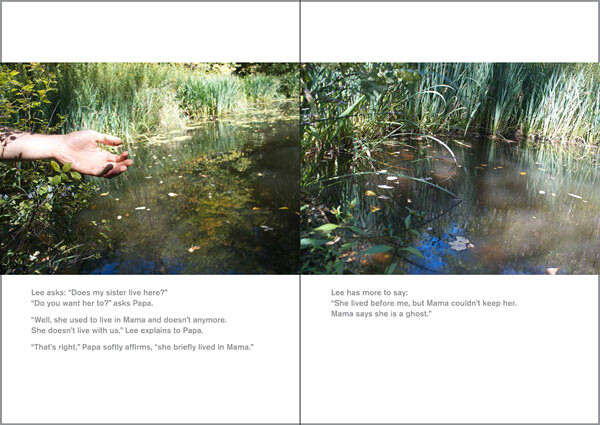

The Constructions of a Child Protagonist within the Polemical Dimensions of Abortion
Reasons for The Conscious Absence of the Protagonist’s Face:
A. Protection of subject
B. The history of the blank face and child represents:
1. The blank-faced carved pioneer doll
2. The blank-faced cloth Amish doll
3. The blank-faced digital image from a crime scene
C. To release the viewer from assigning a specific gender
D. The grace of projection
The Ethnic Markers of Protagonist and Antagonist:
The visual marker that categorizes the child protagonist as “white” was deliberately chosen to reflect the dominant anti-choice demographic as represented by mainstream US media. It would follow that Sister, Lee’s aborted sibling, is also read as white. This decision to portray Sister as white aims to move against the historical forced sterilizations of poor women, which overtly targeted indigenous women. Additionally, it is my hope that the provocation is more acute when the (white) pro-life poster child is retained but morally resituated.
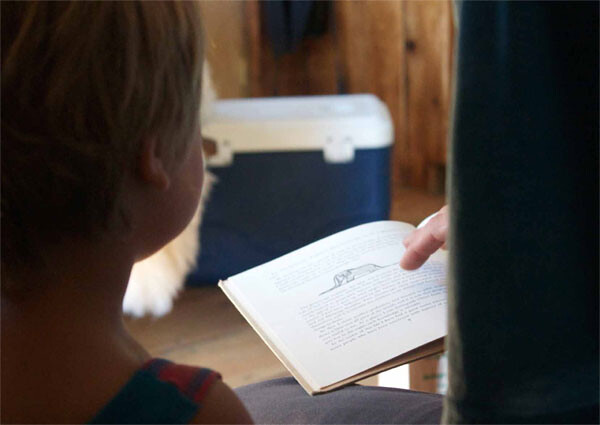

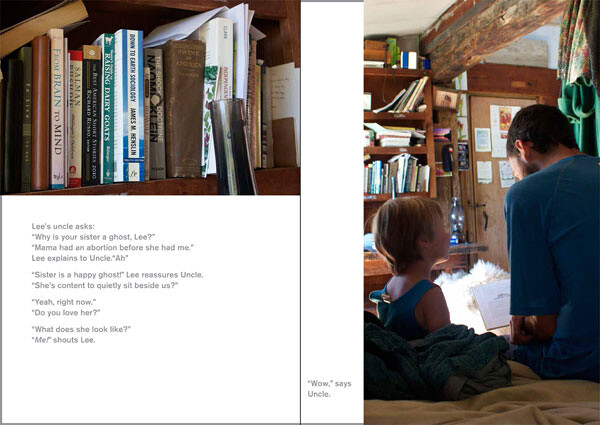

Dead Ends, Empty Libraries, Abandoned Projects
Theses on socially motivated, photo-illustrated children’s books; photo-illustrated, socially motivated, pro-choice children’s books; and pro-choice children’s books authored and illustrated by children. Anti-choice children’s books authored and illustrated by children could not be located. Search conducted from 2010 to 2013:
1. Digital archives were a bust. The Brooklyn Public Library’s children’s room librarian (main branch) communicated that photo-illustrated books were not identified as such in the card catalog, that they were indeed the minority of their holdings, and that to her recollection there were no socially motivated, photo-illustrated children’s books in their holdings. Rural collections did not diverge. The librarians overseeing children’s books in New England libraries reported that the children’s collections were “weeded.” Unpopular or aging books were regularly discarded because of the prohibitive cost of archiving. Thus, there were no detectable remnants of sociopolitical literary memes within children’s literature.
2. Adults fantasize that the production of children’s books will allay the nightmare of the present or disrupt the ideological grounds informing the future. In glass vitrines at the Guggenheim, a visitor could glimpse several pages excerpted from a magazine for children called Kirin (Giraffe) produced by the Gutai group in the wake of World War II. In it, Shimamoto Shozo urges children to mischief, and then urges them against it. This missive to the infants cannot find its political footing. Hot potato, it leaps left to right.
3. Maya Deren also yearned to turn the genre, to base a children’s book on the anthropological origin of movement, realized as a suite of drawings. Deren, then a filmmaker (but first a dancer), aspired to collaborate with Katherine Dunham, then a choreographer and dancer (but first an anthropologist). Dunham had previously urged Deren to consider the synthesis of movement and anthropology, and introduced her to the notion that Haiti could be the source and site of this fusion. Some claim Deren failed to acknowledge Dunham’s contribution to Deren’s Divine Horsemen. Where does the children’s book fall in the Dunham/Deren timeline? The anti-process of their nixed collaboration outlines the phenomenon of a book made impossible by bad politics: Deren’s attachment to the cult of genius as well as hierarchies scored by sex and race.




A Random and Incomplete Annotated Bibliography
Surrealist Imaginary Photo-Illustrated Children’s Book:
Le Coeur de Pic (1937)
Photographs: Claude Cahun
Author: Poemilise Deharme
Photo-Illustrated Children’s Literature / Adult Picture Books:
The Lonely Doll (1957)
Author and Photographer: Dare Wright
The virgin author models the doll after herself (which is a self that appears to be modeled after dolls). Does sublimated child-woman effectively operate as child narrator? Also note: the psychosexual depictions of play, punishment, and punishment-as-play become incidentally, retroactively political—at best, these function as faint introductions to sexual transgression (if one reads “the Papa Bear” as a naked, authoritative proto “furry” in the subculture of animal role-playing; if one chooses to transmute the spank from assault to the liberatory charms of S/M; and if one wishes to entertain the notion that the Papa Bear and his cub can be hallucinated as the breaking and entering of queer working class masculinities within upper middle class environs; if).
Inner City Mother Goose (1969)
Graphic Design: Lawrence Ratzen
Author: Eve Merriam
A version of Mother Goose including police brutality, job discrimination, urban segregation within a greater structure of racial inequality. Is there an audio record of these poems being read to children?
Socially Motivated, Photo-Illustrated Children’s Literature (Late 1950s / Early ’60s):
The earliest example readily accessible via the internet is Cornell Capa’s unpublished Mario. The mock-up is lodged within an unnamed collection (no explanation is provided as to why it was never published). The singular and visually seductive web representation features the “dummy” resting in a denim lap held by white hands. Whose hands? (The borrower’s hands.) The narrative does not definitively belong to Mario, a Quechuan boy, the child of farmers in mid-century Peru. Sam Holmes “ghost writes” the subaltern (uh …) and the story that unfurls follows Mario’s trajectory from mountain village farm to the home of an affluent expatriate American boy:
A phone began ringing in the bedroom
–“What is that,” Mario asked.
–“The telephone,” Simon said.” Answer it.” [Simon is naked in the tub.]
–“Which is the telephone? What do you mean answer it?”
–“It’s the black thing on the table near the end of the bed,” Simon said. “Go pick it up and put the little end to your ear and talk into the big end.”
Holmes imagines that Mario imagines that Simon’s mother is somehow in the phone, requesting that Mario summon Simon from the bath. Bodies imagining some bodies inside of things. Some Americans encrusted in luxury objects.
Capa and Holmes expose the hegemonic power structure that attaches Mario’s fate to Simon’s actions; however, the seemingly unconscious manner in which insidious play suffuses Mario’s lack of agency undermines “the concerned photographer’s” ideological agenda.
1970s Explosion/Fruition (Ripening, Decay) of Genre in USA:
Subgenres: “Ecology,” “Inner City,” “Back to the Land,” “Gender Equality” Markers:
– Second-person child narrative
– Second-person child narrative
– Emphasis on daily condition of the child (as imagined by adults)
– Narrative driven by child protagonist’s decisions
– Sociopolitical realities directly represented by photographs
– Black and white photographs (because this is social evidence)
– Presumption that child is an active agent in the production of his or her own political consciousness
– Intimate, detailed photos that cater to children’s aesthetic sensibilities
– Producers untroubled by the instrumentalization of children within various political discourses
– Greater demographic range of protagonist (class, race, gender)
– Unlike much of Chinese children’s literature produced during the Cultural Revolution (1966–76), the children do not talk and behave like “adult political instructors.” The Americans do not deploy “abstract revolutionary rhetoric.”7
The following bibliographic portion singularly consists of books that came into the writer’s possession because they had been discarded by a library (A Calf is Born), sold for a dollar at a country yard sale (J.T.), or abandoned on the street (Danny Goes to the Hospital):
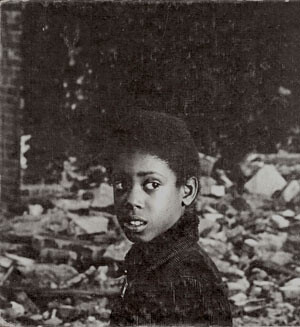

J.T. (1969)
Author: Jane Wagner
Photographs: Gordon Parks Jr., director of Superfly (1971) and Three the Hard Way (1974).
Based on a TV movie produced by CBS for the children’s hour, it includes a written summation of the network’s critical agenda. This summation recalls a literary device common to eighteenth-century British children’s literature, in which the moral intent of the author was explicitly outlined in order to tip the scales. To what extent did major television networks (late ’60s–late ’70s) initiate and screen socially progressive programs for economic gain? Was J.T. part of a progressive zeitgeist that included Sister Corita Kent’s Christmas eve broadcasts on major television networks (Kent was a radical nun and artist)? If socially progressive, photo-illustrated children’s literature and the potential roots of radical television wither in tandem, what struck equally at their base?
The inside flap of J.T. reads:
To the guys on the block, J.T. is the kid who stole the radio out of the red convertible before they could get to it. His neighbor, Mrs. Morris, declares him a first-class nuisance. His mother is bewildered—“He’s just gone bad, that’s all … Stealin’ and lyin’ and I don’t know what all.” But all the sensitivity, responsibility, and care of which ten-year-old J.T. Gamble is capable emerges when he finds an old, one-eyed, badly hurt alley cat. J.T. takes on a new dimension as he lavishes all the love he is unable to express to people around him on the battered cat he has found in the junk-filled empty lot.
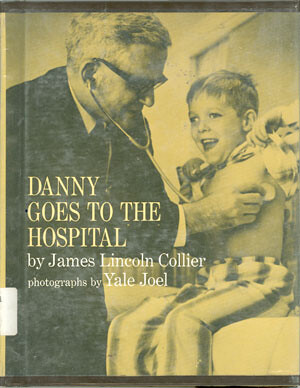

Danny Goes to the Hospital (not radical, not political) (1970)
Note: The visual grammar of Life magazine’s photo-essays is reproduced by employing Life photographer Yale Joel. The book presents as intact subjectivity a Caucasoid middle class American household with absolute support from the other as an uninterrogated surface. The visual grammar is retooled by radical authors of the ’70s.
James Lincoln Collier (author) recounts Danny’s operation (Danny’s lazy eye migrates to the side of his socket, but this condition is never named). Danny’s eye is a straying organ, shepherded by the scalpel.
The book was found in a free box in Brooklyn, New York in 2011; however, the interior pages were stamped “P.S. 31 Brooklyn.” The inside cover indicates that the book was never once checked out.
Finally: A claim should be made that Collier has begun to address disability (as Danny’s condition is both a social stigma and a hindrance to depth perception). Danny’s operation appears to alleviate the problem, restoring Danny’s social relations and sight. Is the temporary nature of Danny’s condition counter to its political instrumentalization?
It was awkward, this book in my hands. In 1982, I underwent the same operation as Danny. (Vomiting as a prominent side effect is omitted from Danny’s tale.) My pupil eventually ceased floating to the right unbidden (twenty-three years later). What did the right eye “see” when the left looked forward? The side story, the runoff. I would like to make a film that records what was collected but unregistered. What lies in the optic gutter?


A Calf is Born (1975)
A series of photographs documenting a year in the life of a semi-industrial dairy cow. Includes graphic close-ups of a calf’s birth. The young reader/milk-drinker is included within the cycle of production.
Note: The visual inclusion of the placenta’s expulsion is not solely a commitment to depicting a process but, in addition, illustrates a cultural moment where the natural, the psychedelic, and the political converge. Discarded by Jaffrey Public Library in 2012. (Calf as child protagonist.)
1980s Waning of Radically Charged, Socially Motivated, Photo-Illustrated Children’s Books (i.e., Gender, Race, Ecology at Center):
Emphasis on differently abled bodies and the social acceptance of physical ability.
Is this literature produced by both the Left and the Right? When did the evangelical anti-choice movement begin to introduce a new argument that mobilized sympathetic narratives of children with disabilities? The cynic wonders if the outgrowth of this genre is the convergence of evangelical and feminist body politics in the ’80s, both generating parallel materials urging the reader to reconsider the viability of bodies previously framed as abject.
In Rindge, New Hampshire, the public library serves a primarily rural, Republican constituency; in the stacks, three photo-illustrated children’s books feature the lives of children contending with a range of physical differences that limit their mobility. The pedagogical intentions of the 1970s have clearly receded. The graphic design no longer emphasizes the visual perspective of small children, and the number of images have been reduced. Lengthy and unwieldy texts underscore the distinction between an adult readership and a child readership. The intended audience is obfuscated: A child with the same condition as the protagonist? A peer? His or her parents? Is the book a salve or a proviso? Which librarian selects and purchases a Scandinavian photobook of a hospital for differently abled children? Will this be read at children’s hour? What tone shall be struck when describing Arno’s exhaustion? (The accompanying photographs show Arno, who was born without arms and legs, in a box.) The following page reveals that three-year-old Arno is dead. The question floats: Is this disability porn? (Images that dilate the condition of bodily-ness for the edification of the stranger.)
The Strength of the Hills (1989)
Breaks markedly with the farm-based, photo-illustrated books of the 1970s. The child reader must negotiate long textual explanations, a critique of the contemporary corporatization of dairy farming, and long-view images aligned with adult perspectives of land and labor. The political intent of the genre is intact, but the visual means and pedagogical tactics are not. Still in circulation at Chelsea Public Library, Vermont 2013.
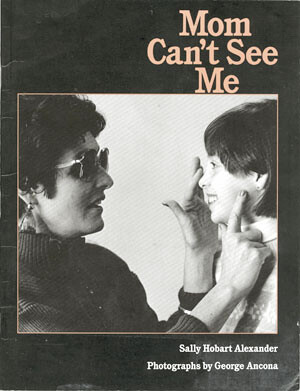

Mom Can’t See Me (1990)
Stresses the strategies employed by a heterosexual, suburban, white, middle class family in order to adjust to a mother’s blindness. The mediated exposure of private reality is central to the politicization. It asks the reader to dilate the contours of “normalcy” rather than questioning the category itself.
Non-Existent Books For Children (A Cryptobibliography)
K. Kondo, Mother’s Day is Bullshit! (Tokyo: Hakusensha, 1979). Photo-illustrated account of anti-Mother’s Day protest organized by feminist mothers and their children (in strollers) in Tokyo.
Antonin Artaud, Sperm! Illustrations by J. Panlevier. Private commission for undisclosed collection. Series: Artists’ books on human sexual reproduction for children. Note: Panlevier, underwater cinematographer, directed and shot a film that features the pregnancy and labor of the male seahorse. The text of Sperm!, written by Artaud, is explosive, scarring, and confusing.
Buffy St. Marie, Unthanksgiving Day (Boston: Little Brown, 1971). Photo-illustrated account of the occupation of Alcatraz Island by the American Indian Movement. Narrative is told by one of the children who accompanied her parent to the island in 1969 and focuses on the supplanting holiday, Unthanksgiving Day. Accompanying album features Buffy St. Marie, who demonstrated her support for the action by visiting the occupation on Alcatraz Island.
Benjamin Smoke, Paul(a) Bunyan: Cross-Dressed Paper Dolls From 19th-Century American Logging Camp Dances (Atlanta: Cabbagetown Press, 1988). 25 illustrated pages. 6 paper dolls, including wooden lady.
Swiss Commission on Nuclear Disaster and Civilian Preparation, Saint Safety (Geneva: Government of Switzerland, 1989). 20 illustrations by Balthus. Note: A small girl follows the adult civilian assigned, in the wake of a nuclear disaster, to pack and transport the Catholic saint of protection and his accompanying dog statuette to a fallout shelter. Once a month, each Swiss civilian enacts his or her assigned role: the small girl is introduced to the concept of collective national action and to the notion that there never has to be an end. Apocalypse deferred, again again.
Postscript
The Unthinkable Book casts about for a perverse narrator: the one that reads childishly about unchildish things to a child.
This impossible book casts about for a notional listener: callow yet capable of parsing a spirit from its surgical remains (read: abortion), a listener willing to toddle through a simulated moral universe dependent on a child protagonist’s nascent sense of agency as tempered by imagination.
This book floats away from an exhausted ethical binary (the polemics of Left or Right, secular or religious, dead or alive) produced in relation to the deliberate termination of human pregnancy. Our book’s ethereal antagonist is neither dead nor alive. And, although it is true that she’s joining a mythic gang of infant dead (from the folkloric and sonic Frozen Charlotte to the literary Beloved [Toni Morrison]), unlike her fellow wraiths, Sister doesn’t cleave or cling. She has won lone reprieve from the aesthetic and repetitive machinations of cultural trauma embodied by the apparition. Henceforth, our Narrator asks Reader and Listener to seek a third path, a subtle and complex reckoning with benevolent killing (of plants, of beasts, and children).
Download Sister Apple, Sister Pig.
Advertisement for Victorian-era abortionist Madam Restell, c. 1870, quoted in Marvin N. Olasky, Prodigal Press: The Anti-Christian Bias of the American News Media (Wheaton, IL: Crossway Books, 1988), 187.
Second-wave publications such as the Redstockings Newsletter contrived this connection wholeheartedly; consciousness raising, for instance, was founded on a kind of discourse-as-expertise apparatus, where the experience was legitimized as a practice requiring—well, practice—in order to truly understand. Per Barbara Susan’s “About My Consciousness Raising,” Redstockings Newsletter, November 1968.
Naomi Wolf, “Our Bodies, Our Souls,” The New Republic, October 16, 1995. This article helped to galvanize the feminist community against Wolf’s third-wave politics; Dawn Skorczewski’s counter-argument published in On Our Backs helped give shape to this debate as it unfolded.
I refer here to the tendency in logical positivism to rely on observable results, relegating emotions and metaphysics to the margins of epistemological experience. As Walling Blackburn’s notes imply, Surrealism and the countercultural movements that it inspired were instrumental in using emotion and metaphysics to complicate the relationship between photographic evidence and “the facts.” As André Masson said in 1941, reflecting on the Surrealists’ gleeful rejection of Enlightenment philosophy, “For us, young surrealists of 1924, the great prostitute was reason. We judged that Cartesians, Voltaireans, and other officials of the intelligence had only made use of it for the preservation of values which were both established and dead.” He then admitted that this viewpoint had been too absolutist, and quoted the Romanticist critic Friedrich Schlegel’s assertion that “the contrary of a fault is another fault.” Masson’s admission feels, in the context of Walling Blackburn’s project, like a poetic reflection of the failures of 1960s countercultures to also fully unseat Enlightenment values. See Masson, “Peindre est une Gageure,” Cahiers de Sud, no. 233 (March 1941); reprinted in André Masson, Le plaisir de peindre (Paris: La Diane francaise, 1950), 11–18.
It is not a coincidence, I think, that challenges to logical positivism arose at the same time as feminist and activist challenges to what constituted learning and authority in general—in the late 1950s and early ’60s.
In Man at Play (1923) Karl Groos allocates one section to a cursory investigation of “the luxury of grief” in European contexts. Groos describes a bourgeois individual who draws upon distress as a form of play, aiming for a certain “mental suffering, a feeling of suspension between pain and pleasure.” Lee, the protagonist of Sister Apple, Sister Pig, allays the possibility of repressed psychic distress by the active formation of an ally born of that anxiety. Lee does this without lingering in the interstitial space between pleasure and pain. Is there a political stratagem here … when sorrow and fear become light and active?
In Man at Play (1923) Karl Groos allocates one section to a cursory investigation of “the luxury of grief” in European contexts. Groos describes a bourgeois individual who draws upon distress as a form of play, aiming for a certain “mental suffering, a feeling of suspension between pain and pleasure.” Lee, the protagonist of Sister Apple, Sister Pig, allays the possibility of repressed psychic distress by the active formation of an ally born of that anxiety. Lee does this without lingering in the interstitial space between pleasure and pain. Is there a political stratagem here … when sorrow and fear become light and active?
